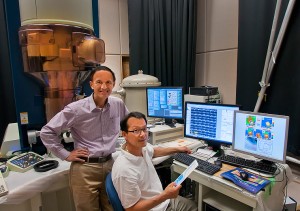
Scientists at Brookhaven National Laboratory, have developed a technique called electron holography to capture images of the electric fields created by ferroelectric materials atomic displacement. The new method give picometer precision that is crucial for learning more about these promising nanoparticles. If we can learn how to manipulate these nanoscale materials there is potential to lay a foundation for future more compact, efficient, and innovative electronic devices.
In research published online July 8 in the journal Nature Materials, scientists at the U.S. Department of Energy’s Brookhaven National Laboratory, Lawrence Berkeley National Laboratory, and other collaborating institutions, describe one such advance, a technique to store digital information. The scientist have revealed unprecedented details about the atomic structure and the behaviour of exotic ferroelectric materials, and how they are uniquely equipped to store information.
By applying different levels of electricity and adjusting the temperature of the samples, researchers demonstrated a method for identifying and describing the behaviour and stability of ferroelectrics at the smallest-ever scale. This in turn could have major implications for future data storage, and usher in a new generation of advanced electronics.
“This kind of detail is just amazin, for the first time ever we can actually see the positions of atoms and link them to local ferroelectricity in nanoparticles”, said Brookhaven physicist Yimei Zhu. “This kind of fundamental insight is not only a technical milestone, but it also opens up new engineering possibilities.”
Current magnetic memory devices write information into ferromagnetic materials by flipping the intrinsic dipole moment to correspond with the 1 or 0 of a computer’s binary code. In the ferroelectric model of data storage, applying an electric field toggles between that material’s two electric states, which translates into code.
“Ferroelectric materials can retain information on a much smaller scale and with higher density than ferromagnetics”, Zhu added. “We’re looking at moving from micrometres down to nanometres. And that’s what’s really exciting, because we now know that on the nanoscale each particle can become its own bit of information.”
The study revealed that the electric polarity could remain stable for individual ferroelectric materials. This means that each individual nanoparticle can be used as a data bit. However, because of their fringing fields, ferroelectrics need five nanometres space to effectively operate. If the distance is not keep, once scaled up for computer storage, the nanoparticals would not be able to keep the stored code intact, and the information could become garbled and corrupted.
“Properly used, ferroelectrics could ramp up memory density and store an unparalleled multiple terabytes of information on just one square inch of electronics”, said Brookhaven physicist Myung-Geun Han. “This brings us closer to engineering such devices.”
